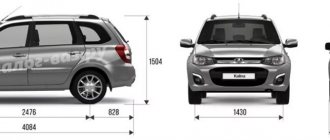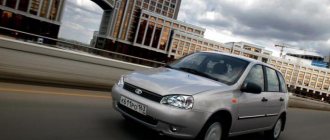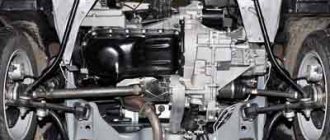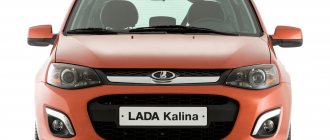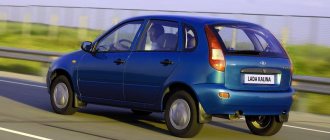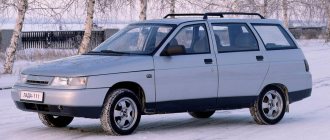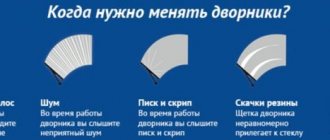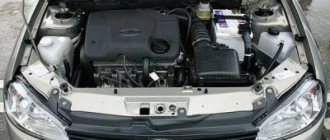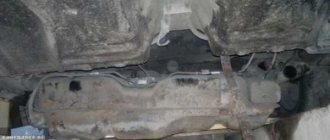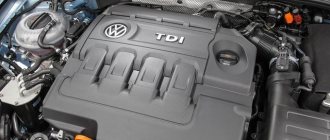For those who are interested in purchasing a Lada Priora station wagon, the technical characteristics of the body, engine and suspension are equally important. "Lada Priora" is the direct heir and successor of the flagship family of VAZ 2110 models of the Volzhsky Automobile Plant. Several hundred changes were made to the design of the car, so the VAZ-2170, VAZ-2171 and VAZ-2172 models (sedan, station wagon and hatchback, respectively) are considered to be a separate family. The first sedans went on sale in 2007, and station wagons in 2009. The Lada Priora station wagon is the most practical and spacious car in the family. At the end of 2015, AvtoVAZ stopped producing and accepting orders for this model.
Those. characteristics
Lada (VAZ) 2170 (Priora) (2007(2013)) 2013 – present gg.
| Brand and modification | Body type | Volume | Power | Release |
| Lada (VAZ) 21703 (Priora) | sedan (4 doors) | 1596 cm3 | 98 hp | 03.2013 – present |
| Lada (VAZ) 21703 (Priora) | sedan (4 doors) | 1596 cm3 | 106 hp | 03.2013 – present |
| Lada (VAZ) 21713 (Priora) | station wagon (5 doors) | 1596 cm3 | 98 hp | 2013 – present |
| Lada (VAZ) 21713 (Priora) | station wagon (5 doors) | 1596 cm3 | 106 hp | 2013 – present |
| Lada (VAZ) 21723 (Priora) | hatchback (5 doors) | 1596 cm3 | 98 hp | 2013 – present |
| Lada (VAZ) 21723 (Priora) | hatchback (5 doors) | 1596 cm3 | 106 hp | 2013 – present |
| Lada (VAZ) 21728 (Priora) | hatchback (3 doors) | 1596 cm3 | 98 hp | 2013 – present |
| Lada (VAZ) 21728 (Priora) | hatchback (3 doors) | 1596 cm3 | 106 hp | 2013 – present |
Lada (VAZ) 2170 (Priora) (2007) 2007 – 2013
| Brand and modification | Body type | Volume | Power | Release |
| Lada (VAZ) 21701 (Priora) | sedan (4 doors) | 1596 cm3 | 81 hp | 04.2007 – 2013 |
| Lada (VAZ) 21702 (Priora) | sedan (4 doors) | 1596 cm3 | 89 hp | 03.2007 – 2013 |
| Lada (VAZ) 21703 (Priora) | sedan (4 doors) | 1596 cm3 | 98 hp | 04.2007 – 2013 |
| Lada (VAZ) 21713 (Priora) | station wagon (5 doors) | 1596 cm3 | 98 hp | 05.2009 – 2013 |
| Lada (VAZ) 21721 (Priora) | hatchback (5 doors) | 1596 cm3 | 81 hp | 02.2008 – 2013 |
| Lada (VAZ) 21722 (Priora) | hatchback (5 doors) | 1596 cm3 | 89 hp | 05.2009 – 2013 |
| Lada (VAZ) 21723 (Priora) | hatchback (5 doors) | 1596 cm3 | 98 hp | 02.2008 – 2013 |
| Lada (VAZ) 21728 (Priora) | hatchback (3 doors) | 1596 cm3 | 98 hp | 01.2010 – 2013 |
View technical characteristics of other Lada (VAZ) / Lada (VAZ) models
The automobile catalog contains descriptions, technical characteristics and photographs of Lada (VAZ) 2170 (Priora) / Lada (VAZ) 2170 (Priora) cars produced since 1997.
Facelift
On the training ground we looked like children looking for differences in two seemingly identical pictures. So, looking back at the pre-restyling car, which we immediately dubbed old, we begin to bend our fingers, counting the updates. The front bumper, which appeared on the model last year, has not changed, so at first glance both Prioras appear the same.
The only difference is the plastic radiator grille - the new honeycomb structure has refreshed the exterior. Although at a distance the honeycombs still need to be seen. The headlights are the same. I agree with the opinions of the owners on numerous forums: they work as they should.
In the stern, the main focus is on the lights. Now in their lower part there are LEDs, which are longer lasting than ordinary lamps that are on a white car. Larger reflectors on the bumper also help to outline the dimensions. At dusk, the new lighting technology really showed itself better - it was noticeably brighter.
Modifications of Lada Priora
Lada Priora 1.6 AMT
| Maximum speed, km/h | 183 |
| Acceleration time to 100 km/h, sec | 11.4 |
| Engine | Petrol |
| Working volume, cm3 | 1596 |
| Power, hp / rpm | 106/5800 |
| Torque, Nm/rpm | 148/4200 |
| Combi consumption, l per 100 km | 6.6 |
| Gearbox type | Robotic, 5 gears |
| Drive unit | Front |
| Show all characteristics | |
Lada Priora 1.6 MT
| Maximum speed, km/h | 176 |
| Acceleration time to 100 km/h, sec | 12.5 |
| Engine | Petrol |
| Working volume, cm3 | 1596 |
| Power, hp / rpm | 87/5100 |
| Torque, Nm/rpm | 140/3800 |
| Combi consumption, l per 100 km | 7.0 |
| Gearbox type | Mechanical, 5 gears |
| Drive unit | Front |
| Show all characteristics | |
Lada Priora 1.6 MT 106 hp
| Maximum speed, km/h | 183 |
| Acceleration time to 100 km/h, sec | 11.5 |
| Engine | Petrol |
| Working volume, cm3 | 1596 |
| Power, hp / rpm | 106/5800 |
| Torque, Nm/rpm | 148/4200 |
| Combi consumption, l per 100 km | 6.9 |
| Gearbox type | Mechanical, 5 gears |
| Drive unit | Front |
| Show all characteristics | |
Lada Priora 1.6 MT 98 hp
| Maximum speed, km/h | 183 |
| Acceleration time to 100 km/h, sec | 11.5 |
| Engine | Petrol |
| Working volume, cm3 | 1596 |
| Power, hp / rpm | 98/5600 |
| Torque, Nm/rpm | 145/4000 |
| Combi consumption, l per 100 km | 6.9 |
| Gearbox type | Mechanical, 5 gears |
| Drive unit | Front |
| Show all characteristics | |
Station wagons LADA Kalina, Priora
The low threshold of the Priora trunk is not an obstacle when loading.
But the overhanging fifth door is an unsafe barrier to the loader’s head. The low threshold of the Priora trunk is not an obstacle when loading. But the overhanging fifth door is an unsafe barrier to the loader’s head.
However, our installer friends do not live by their luggage alone - we still need to get to construction! On the move, Kalina evokes conflicting feelings. It seems that the 1.4-liter engine (this is the version tested) can be confidently called modern (and economical), but its power is not enough even for an empty car. How will it accelerate when fully loaded? The station wagon loses all semblance of dynamics and, like a KamAZ with a full tank, becomes an obstacle to the flow. What a flow there is - even at the start the engine choke, you have to add gas, fire the clutch.
Technical characteristics of Lada Priora sedan 1.6 liter 8v 5-speed manual transmission
| Motor power | 80 hp |
| Torque | 120 Nm |
| Acceleration to 100 km/h | 12.5 s |
| Max. speed | 172 km/h |
| Fuel type | AI-95 |
| Consumption in the city | 9.8 l |
| Highway consumption | 5.8 l |
| Mixed flow | 7.6 l |
| Volume of the tank | 43 l |
| Trunk volume | 430 l |
Station wagons LADA Kalina, Priora
Having loaded the “installer’s kit” into the Priora, we discovered that there was still room for several more boxes.
Having loaded the “installer’s kit” into the Priora, we discovered that there was still room for several more boxes.
“Priora” is somewhat similar to its rival. The same “empty” steering wheel (its rotation is accompanied by a quiet but annoying buzzing of the electric booster), quite decent smoothness. But the dynamics are much better, even with the air conditioning on. It is clear that with it the car accelerates not as quickly as with it not working, but there is no need to be ashamed. And if you remember that, according to the passport data, the fuel consumption of both station wagons is almost the same, then the conclusion which one wins suggests itself. However…
Disadvantages, breakdowns and problems of Lada Priora 2170
Body
The body's resistance to corrosion is weak; rust can already be found on two-year-old cars. The paintwork is thin, chips form quickly and literally immediately turn yellow.
Salon
The interior begins to squeak from the first kilometers and over time the squeaks only intensify. There is no sound insulation here, the front seats are uncomfortable, and the back is quite cramped.
But the main headache is the electrics. Anything breaks here, anytime. Moreover, repairs do not guarantee that the same thing will not fail again the next day.
Engine
There were four 1.6-liter power units, but their main problems were generally similar:
- failure of sensors, and on new engines and electronic throttle
- breakage of the timing belt due to old age, a wedge of one of its rollers or a water pump
- sticking of the thermostat, followed by engine overheating and gasket breakdown
- oil leaks causing it to get into the spark plug wells and fogging of the ventilation breather
Transmission
The original mechanics of the VAZ 2170 are essentially a slightly strengthened version of the Lada 110 gearbox and are famous for unclear switching, release noise and weak synchronizers.
The new manual transmission VAZ 2180 with cable drive is more reliable and more pleasant to use. The VAZ 2182 robot has received mixed reviews, read about it in a separate article.
Suspension
The suspension is the car's strong point and is ideal for our roads. Reliability is quite good; the first things to be replaced here are steering ends and wheel bearings. Next, the ball joints and support bearings of the struts fail, but they are inexpensive.
The brakes are quite normal, but the original pads need to be replaced as soon as possible. The first years of production there were a lot of problems with a defective electric power steering.
Station wagons LADA Kalina, Priora
The compact Kalina impresses with its cargo capacity.
The staircase, although with difficulty, went in! They didn’t try to see if the water pump would fit. The compact Kalina impresses with its cargo capacity. The staircase, although with difficulty, went in! They didn’t try to see if the water pump would fit.
It is better for tall “high-altitude climbers” to bend down - here the door hangs a little closer to the head. But it is much more important that it is easier to lift the boxes: the loading height is less, and the side is half as low as in Kalina. Are you packed? Why did one of the boxes seem to have fallen through somewhere? It turns out that the side elements of the raised floor hang over the niches in the wings without any support. This means that a heavy load should be placed only in the middle of the floor, above the spare wheel. And so they did. And we realized: there is more free space here. True, the ill-fated generator with a ladder was still left behind... Let’s again resort to transforming the salon “furniture”.
Specifications
Below we will talk about each element of the Lada Priora separately, namely, we will consider separately the body, engine, trunk, etc.
Body
Priora was produced in several bodies. In 2007, only a sedan appeared; later, in 2008, the first hatchback and station wagon rolled off the assembly line.
Sedan 2170
This body turned out to be very nice and most popular among young people. Young people started buying Priora and subjecting it to various tunings. It became a kind of youth movement.
Station wagon 2171
This type of body is an excellent solution for family people. The station wagon is equipped with a huge trunk.
Hatchback 2172
The hatchback does not differ from the sedan in technical characteristics and the front part of the body, but is shorter by several centimeters, which is noticeable to the naked eye.
Engine
Several types of engines with different power and number of valves were installed on the Lada. The table below shows all installed engines and their characteristics.
| Model | 21126 | 21127 | 21116 |
| Number of valves | 16 | 16 | 8 |
| Power (hp) | 98 | 106 | 87 |
| Type | Petrol | Petrol | Petrol |
| Torque, Nm / rpm | 145/4000 | 148/4200 | 140/3800 |
| Number of cylinders | 4 | 4 | 4 |
| Cylinder arrangement | Row | Row | Row |
| Volume (cubic cm) | 1596 | 1596 | 1596 |
| Fuel | Gasoline AI 95 | Gasoline AI 95 | Gasoline AI 95 |
| Power type | Electronic injection | Electronic injection | Electronic injection |
| Maximum speed, km/h | 183 | 183 | 172 |
| Acceleration time to 100 km/h | 11,5 | 11,0 | 12,5 |
| Average fuel consumption per 100 km | 7,2 | 7,2 | 7,6 |
Gear box
Priora was equipped with several gearboxes depending on the configuration and year of manufacture of the car. All gearboxes are 5-speed
Gearbox with rocker
This gearbox was installed on cars from 2007 to 2013. It is a fairly reliable and unpretentious gearbox, its main “soreness” is the weak second gear, which begins to fly out over time.
Cable gearbox
Installed on cars since 2014. Received a large number of positive reviews, the position of the gears, namely the reverse gear, has changed. The vibrations transmitted to the cabin from the gearbox have been reduced.
Robotic gearbox
In 2014, luxury car models began to be equipped with a robotic gearbox. It is very reliable and unpretentious, but noticeably loses in dynamics compared to a manual transmission.
Other characteristics
| Characteristic | Sedan | Station wagon | Hatchback |
| Height, mm | 1420 | 1435 | 1508 |
| Width, mm | 1680 | 1680 | 1680 |
| Length, mm | 4350 | 4340 | 4210 |
| Wheelbase, mm | 2492 | 2492 | 2492 |
| Weight, kg | 1163 | 1163 | 1088 |
| Number of seats | 5 | 5 | 5 |
| Number of doors | 5 | 5 | 5 |
| Drive unit | front | front | front |
| Wheels | 185/65 R14 | 185/65 R14 | 185/65 R14 |
| Tank capacity, l | 43 | 43 | 43 |
| Trunk volume, l | 430 | 444/777 (with rear seats folded) | 360/705 (with rear seats folded) |
Salon
The interior design, even for 2007, was already outdated. Almost every car enthusiast has said this. The front fascia design is reminiscent of early 2000s Fords. The steering wheel is four-spoke, without buttons. The instrument panel is pointer, with a digital odometer. On the center console there is an analog clock (similar to the “tenth” family) and a heater control unit. The radio was not present - only audio preparation (and regardless of the configuration of the Lada Priora station wagon). The seats are fairly flat, but there is a small center armrest. There are two airbags. Expensive versions have air conditioning and an alarm system. The latter caused many problems for the owners. So, sometimes the central locking did not work. After pressing the button, some of the doors did not close or open.
Another problem of the Lada Priora (including the station wagon) is poor sound insulation. This disease has been plaguing VAZ cars for more than one year (fortunately, this chain ended at Vesta). The plastic rattles loudly inside, the door trim, the drawstring and the rear parcel shelf vibrate. Almost every owner of the Lada Priora station wagon tried to overcome this problem on their own. But in order to “make noise” around the car, you need to spend at least ten thousand rubles on materials. In this case, you will have to completely disassemble the interior. And at a service station the price of such a service will be about 20 thousand rubles.
Another problem is the stove. The Priora uses a motor with micromotor gearboxes that switch the dampers. These gearboxes often fail, causing the stove to blow in only one direction. Sometimes the dampers themselves jam. As a result, air is pumped by the motor, but cannot enter the cabin (or it does, but poorly).
How much does Lada Priora weigh?
The weight of the car before restyling in 2013 was as follows:
- The 3-door hatchback coupe, 5-door hatchback and sedan have a curb weight (which includes the weight of a full tank of fuel and the driver) of 1088 kg. In this case, the total weight (i.e., the maximum permissible weight of the vehicle at which it can be operated after being fully loaded) is 1578 kg;
- The station wagon, with the same curb weight, is able to take a little more cargo, and its total weight reaches 1593 kg.
Thus, the station wagon is the most load-carrying of all Priora body types.
Station wagons LADA Kalina, Priora
You can load heavy items into the Kalina without bending over - this is a plus.
But the high threshold through which you have to pass luggage is a minus. You can load heavy items into the Kalina without bending over - this is a plus. But the high threshold through which you have to pass luggage is a minus.
Having unfolded the seat, we discovered that we could safely add another one of the same type to our “installer’s kit”. A stepladder lay on the flat floor and the tools were laid out. What to do with free space? Of course, the supply has never bothered anyone - what if for particularly complex work you need additional equipment, bulky and heavy? In such a situation, Priora will help out the owner, but its competitor will not.
Cargo capacity
Cargo capacity (not payload!) of the Prior varies depending on the body type. So, trunks have different volumes:
- 360 liters – for hatchback and coupe;
- 430 liters - for the sedan;
- 444 liters - for the station wagon.
As we can see, this volume is not very different from the sedan’s, so it’s a very stretch to say that the Priora station wagon was created to solve a wide range of economic problems (relative to other variants of this car). Of course, cargo capacity increases significantly if you fold the back of the rear sofa, or even better, remove the entire rear seat.
Brake system
The front and rear brakes are different. There are ventilated disc brakes with a single-piston floating caliper and automatic adjustment of the gap between the pads and the disc at the front, and drum brakes at the rear. The brake system is diagonal, dual-circuit, hydraulic. Equipped with a vacuum booster.
It is possible to work with the traction control system. You can also install disc brakes at the rear instead of standard drum brakes. The new braking system will also support ABS. The parking brake is manual, on a cable with drive of the rear wheels.
Dimensions of VAZ 2170 and other modifications of Priora
The dimensions of the car are something that needs to be taken into account when purchasing, since the dimensions of parking spaces, garages, turns or entrance arches are not always universal. The height is measured from the extreme point of the front to the extreme point of the rear bumper. The width is measured at the widest point, and the height is measured from the surface of the ground to the highest point of the roof. Roof rails and racks do not fit into the height of the body. Taking this into account, the dimensions of the Priora are as follows:
- The longest body of cars in this family is the sedan. It measures 4350 mm in length. But at the same time it is the lowest - 1420 mm. in height.
- The next longest is the station wagon, with its 4340 mm length. It is the highest in height – 1508 mm.
- The five-door hatchback and three-door coupe are the shortest - 4210 mm. at 1435 mm. in height.
In all four cases, the width of the Priora is the same - 1680 mm. Ground clearance is 165 mm, although in the Priora Sport configuration it is somewhat reduced, but this is no longer so important, since this car is no longer produced in this version.
Appearance
AvtoVAZ engineers did not invent a bicycle and simply took the sedan body as a basis. So, from the front these cars are completely identical. The Lada Priora station wagon has the same drop-shaped halogen headlights, as well as a modest bumper with round fog lights.
There are massive roof rails on the roof. True, judging by the reviews, none of the owners practically used them. It is worth noting that the angle of the rear door pillar has been reduced. This has a positive effect on the ease of landing. Getting into a station wagon is much more comfortable than sitting in a sedan.
Note that in 2011 the car underwent a slight restyling. Thus, the Lada Priora station wagon body remained virtually unchanged. Among the differences are a larger radiator grille with chrome trim, as well as a reshaped bumper with different foglights. The rest of the car remained the same.
From the rear, the car doesn't look like any kind of van. This is facilitated by large vertical lights and the successful completion of the rear pillar. The trunk lid is quite large and has heated glass. The bumper is raised high, which contributes to good cross-country ability.
Color change
“First impressions: the car needs to be rolled out, it doesn’t drive. There is no sound insulation, locks and door handles require improvement. The standard tires are noisy and dull. You’re riding like you’re on stumps.”
“In two difficult months, the car covered 18,000 km, but did not cause any problems. The chassis, in my opinion, is quite tolerable, the only thing is that a knock is heard in the right pillar when passing speed bumps. I came to the service, looked at it - everything is fine, they say it’s their illness. The brakes are not bad, 4"...
I compare the impressions of Moscow Prior owners with my own. The cars have the same 98-horsepower engines, so there are no fundamental differences in movement. The suspensions regularly absorb large bumps, but shake on small bumps. However, the gray car is more interesting at the level of nuances: it is more composed in corners, a little more stable on the way out, and absorbs road bumps more smoothly.
In terms of acceleration dynamics, the new and old “Priors” are practically no different from each other, while a noticeable monotonous rumble fills the interior. I remember that during our first meeting with the car they told us about improving the sound insulation. We measured the noise level in the cabin (both Prioras were shod with the standard Kama-Euro) and were surprised: the new car turned out to be not as quiet as the previous version! The reason was found in the trunk: it turned out that the carpet in the pre-restyling car was thicker.
The steering is equally uninformative, and the updated car has a sharper steering wheel only in the Lux. We are waiting for him in other modifications.
“The transmission works fine, except for first gear. I switch to lower with effort. This happened to me on all Zhiguli cars, from the “six” to the “ten,” - I continue to study the forum of Prior owners.
The white Priora has a similar behavior, but here the fifth gear is difficult to engage. I push the lever by force, and it doesn’t work the first time. In a restyled car, it is more convenient to operate the lever. New cable driven unit? Unfortunately, no: both have well-known boxes with the VAZ-2112 index, which my colleague was not enthusiastic about when he tried out the new Priora in Tolyatti. Therefore, they decided: these are the features of specific machines. I would like to believe that the better performance of the transmission is evidence of improved build quality. By the way, when the engines are idling, the gearbox levers of our pair vibrate equally strongly.
The brakes lack information content and tenacity of reactions. The mechanisms seem to be lubricated with soap: I press the pedal - and every time I am dissatisfied with the rate of deceleration. I want to push the pedal harder, but the travel is not unlimited.
I remember the “Chinese” - “Lifan-Solano” and “FAW-Oley”, which I had a chance to ride on earlier. I liked the braking performance of these budget sedans much more. I wish the replacement of the Priora that her main automotive system becomes clearer and more reliable.
Well, although our pair is not in the richest configurations, there are more than enough differences between them. But there is also a “Lux”, in which you will find a multimedia system, side airbags and a more powerful 106-horsepower engine. But even without that, the old Priora still pales in comparison to the new one. However, only a new model can correct the global shortcomings of the Priora. Completely new in design.
Anti-aging treatments
As soon as you start the engine, the new car’s low beam headlights flash, even if the switch is in the “0” position - convenient. The indicator squeaks to warn you that your seat belt is not fastened, and when you lightly touch the steering column, the turn signal flashes three times.
I turn on the side lights sequentially, then the headlights... Not one icon appears on the instrument panel, like in an old car, but two. It’s a small thing, but now you don’t have to guess what lighting equipment works.
The new instrument panel is more interesting in terms of design. In general, there were no special complaints about the previous one, but it was too simple and had already become familiar. And then there were the wide white arrows and well-arranged pictograms, and I immediately fell in love with the new product.
The updated dashboard not only refreshed the interior, but also added convenience. The on-board computer screen was placed in the center. There is no unnecessary beauty on the monitor, everything is simple, but large numbers are clearly visible in motion.
The driver's position is praised by many owners, but being 190 cm tall, I feel uncomfortable in the seat: there is very little space in the area of the pedal assembly of the old car, and there is not enough longitudinal adjustment of the seat. The updates have corrected the situation a little: the seat slides in the new car have been lengthened, so you don’t have to lean the back too much back.
The chair is denser, it better fixes the body in turns. The distance between the gas and brake pedals is noticeably greater. Having adjusted the driver's seats in both cars, I tried to sit back and couldn't. The backs were too close to the rear sofas. And if four people get into the car, I, the driver, will have to press my knees to my ears.

